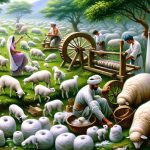Wool, an age-old natural fiber since 10,000 BCE, stems from sheep and boasts warmth and softness. From ancient hand techniques to advanced industrial methods, wool has shaped global markets. Discover its rich history and wide-ranging benefits.
Table of Contents
Key Takeaways
- Wool is an ancient natural fiber dating back to 10,000 BCE.
- Domesticated sheep are the primary source of wool fibers.
- Wool production involves shearing sheep and processing fleece into fabric.
- Wool trade has historical roots in civilizations like the Persians, Greeks, and Romans.
- Wool has evolved from ancient hand methods to modern industrial processes.
Wool: An Ancient Natural Fiber
Wool, an ancient natural fiber, has been a cherished resource for humans since 10,000 BCE. Domesticated sheep are the primary source of this versatile material, providing wool fibers that vary in fineness, length, and quality. Among the many sheep breeds, Merino sheep stand out for producing exceptionally fine wool fibers, prized for their softness and warmth.
The process of wool production begins with shearing the sheep, collecting their fleece, which is then processed to create wool fabric. This fabric has been a valuable commodity throughout history, with wool trade dating back to ancient civilizations like the Persians, Greeks, and Romans. The evolution of techniques in wool processing has enhanced the quality and variety of wool products available in the market today.
Understanding the origins and significance of wool in human history sheds light on its enduring appeal and importance in modern society. From the cozy warmth of a wool sweater to the elegance of a wool coat, this ancient natural fiber continues to captivate us with its unique qualities.
Evolution of Wool Processing Techniques
With the passage of time, wool processing techniques have undergone a remarkable evolution, shifting from ancient hand methods to modern industrial processes. Industrialization revolutionized the way wool was processed, introducing mechanized processes such as carding, combing, and spinning. These advancements markedly increased efficiency and output while maintaining quality.
In modern wool processing, additional steps like scouring, dyeing, and finishing have become standard practices to enhance the quality and versatility of wool products. Technological advances have played a vital role in streamlining the entire wool processing chain, ensuring consistency and superior final products.
The evolution of wool processing techniques highlights the industry's commitment to innovation and excellence, making wool products more accessible and diverse than ever before.
Historical Significance of Wool Production
Having played an important role in human history for millennia, wool production holds immense historical significance. The utilization of wool dates back to 10,000 BCE, underscoring its enduring presence in various cultures and civilizations.
The diverse array of over 1,000 sheep breeds globally contributes to the rich tapestry of the wool production industry, each breed offering unique characteristics suited for different applications. Merino sheep, renowned for their fine wool quality, have been instrumental in the luxury apparel sector, with Merino wool being highly sought after for its softness and warmth.
The introduction of Merino sheep to Australia from Spain in 1789 marked a pivotal moment in the history of wool production, leading to significant advancements in the textile industry. Additionally, sheep breeds like Rambouillet, Romney, and Scottish Blackface have also played important roles in providing wool for various purposes, highlighting the versatility and importance of wool throughout history.
Global Wool Market Insights
Exploring insights into the global wool market reveals its importance and impact on various industries worldwide. The history of wool dates back centuries, evolving into a key player in the textile industry.
In 2021, approximately 1.2 billion sheep produced about 1,945 million kilograms of raw wool, highlighting the substantial role of wool producers in meeting global demand. Leading producers like Argentina, New Zealand, South Africa, the United States, and Uruguay contribute notably to the production of wool, influencing the market dynamics. Australia stands out by producing 80% of the world's Merino wool, a luxurious fiber highly sought after in fashion.
Wool, accounting for 0.9% of the global fiber market, isn't only used in traditional wool fabrics but also finds applications in performance, active, and sportswear due to its exceptional properties. Wool's versatility and quality continue to drive its presence in various sectors, shaping trends and meeting consumer needs worldwide.
Wool: Properties and Practical Applications
Wool, known for its unique properties and versatile practical applications, plays a significant role in a wide range of industries and products.
The stretch and resilience of wool fibers act like tiny springs, providing durability and longevity. Whether wet or dry, wool can stretch up to 50% and 30%, respectively, ensuring flexibility and comfort in various textile applications.
Additionally, wool's ability to regulate temperature by absorbing water vapor makes it suitable for both warm and cool climates. Its flame-resistant nature and ability to felt under specific conditions offer natural protection in fire-related situations.
These versatile properties make wool a sought-after material in the production of clothing, blankets, horse rugs, carpeting, insulation, and upholstery. From combed wool to wool yarn, the practical applications of wool are vast and essential in creating high-quality, functional products across different industries.
Frequently Asked Questions
What Origin Does Wool Come From?
Wool originates from sheep, known for its warmth and versatility. The fiber has been used by humans for millennia, with different sheep breeds worldwide providing varying wool types. Its history dates back to 10,000 BCE.
How Would You Describe Wool?
Warm, soft, and durable, wool is a versatile natural fiber with unique properties like crimp and breathability. Different sheep breeds produce wool with varying characteristics, influencing its quality and uses in various industries.
What Is Wool and Why It Is Important?
Wool, a natural fiber from sheep fleeces, is crucial due to its warmth, durability, and versatility. Its unique qualities like moisture-wicking and flame resistance make it great for clothing and carpets. Wool suits many needs sustainably.
What Are 4 Facts About Wool?
Wool, sourced from sheep, boasts remarkable versatility. It dates back to 10,000 BCE, with over 1,000 sheep breeds globally. Wool production, at 0.9% of the fiber market, involves 1.2 billion sheep producing 1,945 million kilograms annually.
- Woven vs. Nonwoven Bags: Which Is the Greener Choice? - July 11, 2025
- Nonwoven Fabric Production Methods: A Visual Guide - July 11, 2025
- The Ultimate Guide to Nonwoven Polypropylene - July 11, 2025






